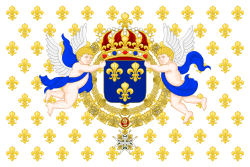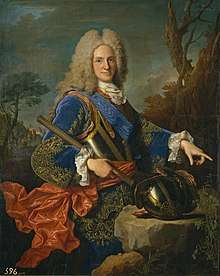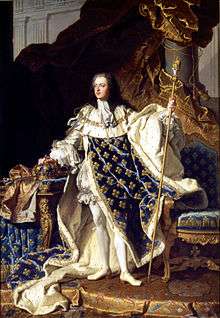Pacte de Famille
The Pacte de Famille (French pronunciation: [pakt də famij], Family Compact; Spanish: Pacto de Familia) is one of three separate, but similar alliances between the Bourbon kings of France and Spain.


| Foreign alliances of France | |||||||||||||||||||||||||||||||||||||||||||||||||||||||||
|---|---|---|---|---|---|---|---|---|---|---|---|---|---|---|---|---|---|---|---|---|---|---|---|---|---|---|---|---|---|---|---|---|---|---|---|---|---|---|---|---|---|---|---|---|---|---|---|---|---|---|---|---|---|---|---|---|---|
| |||||||||||||||||||||||||||||||||||||||||||||||||||||||||
The first Pacte de Famille

The first of the three Pacto de Familia was agreed on November 7, 1733 between Philip V of Spain and his nephew Louis XV of France, in the Treaty of the Escorial.
The War of the Spanish Succession was fought to prevent a union of France and Spain; this meant despite their family ties, the two countries were opponents in the 1718 to 1720 War of the Quadruple Alliance. When Cardinal Fleury became French chief minister in 1726, he sought a closer relationship with Spain; this was made easier by the birth of Louis' heir in 1729, which seemed to ensure the two would remain separate.[1]
Louis' wife, Maria Leszczyńska, was the daughter of Stanislaus I, former king of Poland, deposed by Augustus II in 1709. After Augustus' death in February 1733, Louis saw an opportunity to weaken Austria by backing his father-in-law to regain the throne, while Philip wanted to regain Spanish territories in Naples and Sicily, ceded to Austria in 1714. This led to their participation in the War of the Polish Succession in 1733.[2]
In the treaty, France also agreed to help Spain retake Gibraltar, while Spain agreed to end commercial concessions given to Britain in 1714. Neither of these conditions were fulfilled at this point but these tensions would eventually lead to the War of Jenkins Ear and the War of the Austrian Succession. Although Stanislas failed to regain the Polish throne, France acquired the strategic Duchy of Lorraine, while Philip won back Naples and Sicily for his son Charles.[3]
The second Pacte de Famille
The second Family Compact was made on October 25, 1743 again by King Philip V of Spain and King Louis XV of France in the Treaty of Fontainebleau.
This pact was signed in the middle of the War of Austrian Succession, and most of its clauses had to do with the conduct of the war. The result was the expansion of Spanish influence in Italy when Philip V's fourth son Philip, became in 1748 Duke of Parma, Piacenza and Guastalla.
The third Pacte de Famille
The third Family Compact was made on 15 August 1761 by King Charles III of Spain and Louis XV in the Treaty of Paris.
Charles III was the son of Philip V, making him Louis's first cousin. At this time France was fighting the Seven Years' War against Great Britain. Charles's alliance reversed the policy of his predecessor, Ferdinand VI, who wished to keep Spain out of the war. The agreement involved Spain's allies Naples and Tuscany. The third Pacte however was a complete disaster - the British soon captured both the Spanish capitals of the East and West Indies - Manila and Havana respectively. Worse was to follow - Spain agreed to attack Britain's long standing ally Portugal and thus invaded in 1762 with a large army. British troops numbering near 10,000 supported the Portuguese, but in spite of three attempts the Spanish along with their French ally were heavily defeated losing in total upwards of 25,000 men. With the war lost, France as compensation ceded the rest of Louisiana to Spain at the secret Treaty of Fontainebleau. At the Treaty of Paris the following year Charles III was able to retrieve Havana and Manilla but ceded all of Florida to the British.
Later Franco-Spanish Pacts
- On April 12, 1779, France and Spain signed the Treaty of Aranjuez (1779) by which Spain joined the American Revolutionary War against Great Britain. This treaty was seen as a renewal of the third Pacte de Famille and so was not named the fourth Pacte de Famille.
- In August 1796, Manuel Godoy negotiated and signed the Second Treaty of San Ildefonso with France, which required Spain to declare war on Great Britain. This treaty can not be considered a Family Compact since all French Bourbons had been killed or had fled France during the French Revolution.
References
- Lodge 1931, pp. 146-147.
- Ward 1909, p. 63.
- Ward 1909, p. 64.
Sources
- Lodge, Richard (1931). "English Neutrality in the War of the Polish Succession". Transactions of the Royal Historical Society. 14. JSTOR 3678511.
- Ward, AW (ed), Prothero, GW (ed) (1909). The Cambridge Modern History; Volume VI The 18th century. Cambridge University Press.CS1 maint: extra text: authors list (link)
External links
- François Velde, The Pacte de Famille of 1761. In English, includes French-language text of the Pact.
